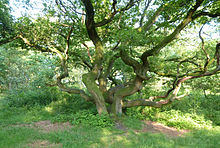Kratt


Kratt is the North German name for a coppice forest with small and partly intertwined trees (cf. Danish Krat ).
A Kratt arises from unfavorable conditions on barren soils and areas exposed to strong winds and due to the special form of cultivation: the trees were repeatedly "cut" to obtain firewood and could only continue to grow by knocking the sticks. Such stands reach heights of up to 3 m. Only a few tree species tolerate this use and are represented in the Kratts, u. a. English oak , quivering aspen , juniper , buckthorn and birch . Kratts with a high proportion of English oak are also known as oak kratts . At Eichenkratts, the bark was also used to make Gerberlohe.
Because of their own, rare and threatened flora and fauna, Kratts are of great value for nature conservation. Since they decreased in number and scope due to the advancing cultivation, some were placed under nature protection early on, for example the Eichkratt Schirlbusch near Drelsdorf in North Friesland or the Reher Kratt . An Eichenkratt is also on the dune natural monument Tateberg an der Lahe .
The name Kratt has been preserved in many hallway and street names.